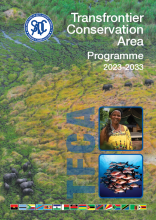The importance of a transboundary and multi-stakeholder approach to manage and guide the way to deal with many of the persistent challenges facing the environment and sustainable develop - ment is increasingly being recognised. Transfrontier Conservation Areas (TFCAs) in Southern Afri - ca are unique landscapes and seascapes that are well suited to the collaborative and coordinated implementation of several Multilateral Environmental Agreements in support of the Sustainable Development Goals (SDGs) and the creation of an equitable, carbon-neutral, and nature-positive world.
The conservation of transboundary ecosystems is subject to a range of policy, legal, governance and management re - gimes, that encapsulate diverse social, cultural, and economic systems. Several Southern African Development Community (SADC) protocols and strategies created an enabling environment for the establishment and development of TFCAs in the SADC region. The SADC Protocol on Wildlife Conservation and Law Enforcement was endorsed by Member States in 1999 and defined TFCAs as the area or the component of a large ecological region that straddles the boundaries of two or more countries, encompassing one or more protected areas, as well as multiple resources use area. A key objective of TFCAs is to collaboratively manage shared natural and cultural resources across international boundaries for improved biodiversity conservation and socio-economic development.
The approval of the 2013 SADC TFCA Programme reinforced Member States’ efforts to establish and develop TFCAs in collaboration with national, regional, and international partners. The SADC Secretariat provided support, mobilised financial and technical resources, as well facilitated platforms for regional knowledge sharing and collaboration

